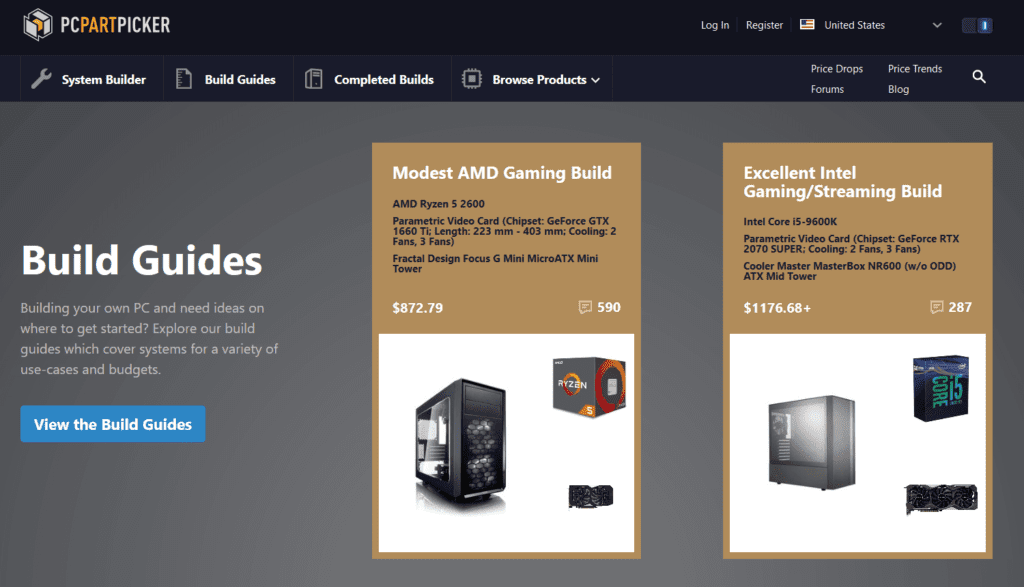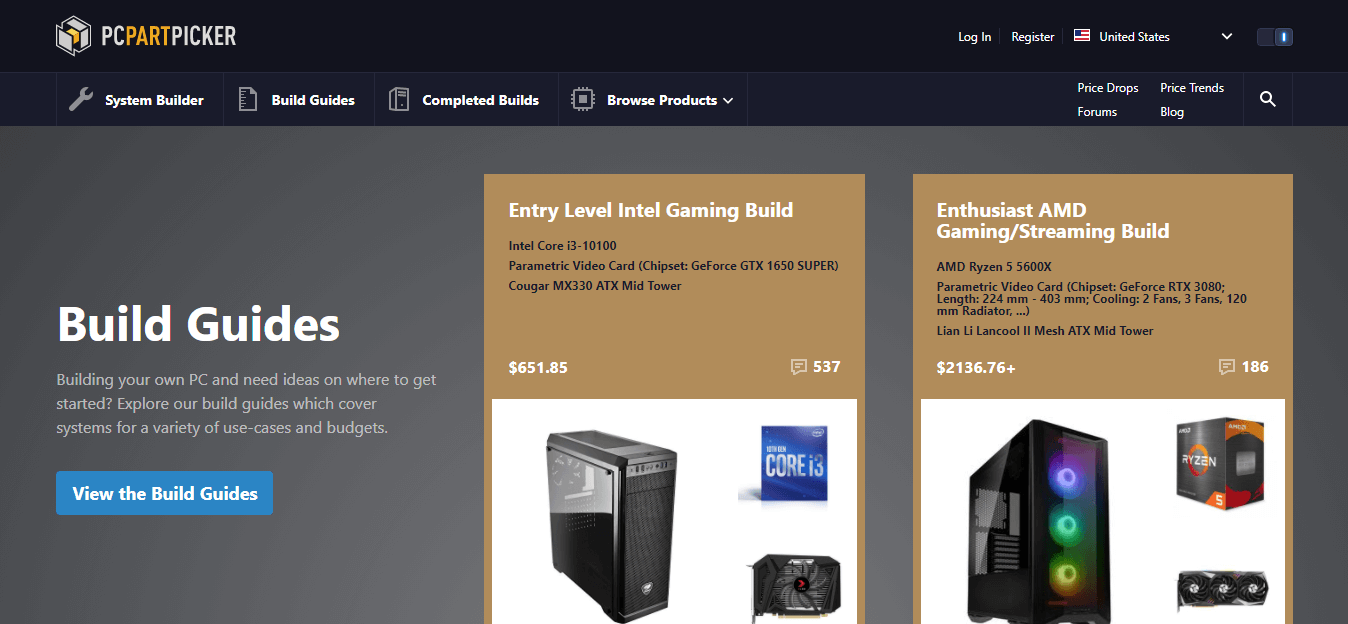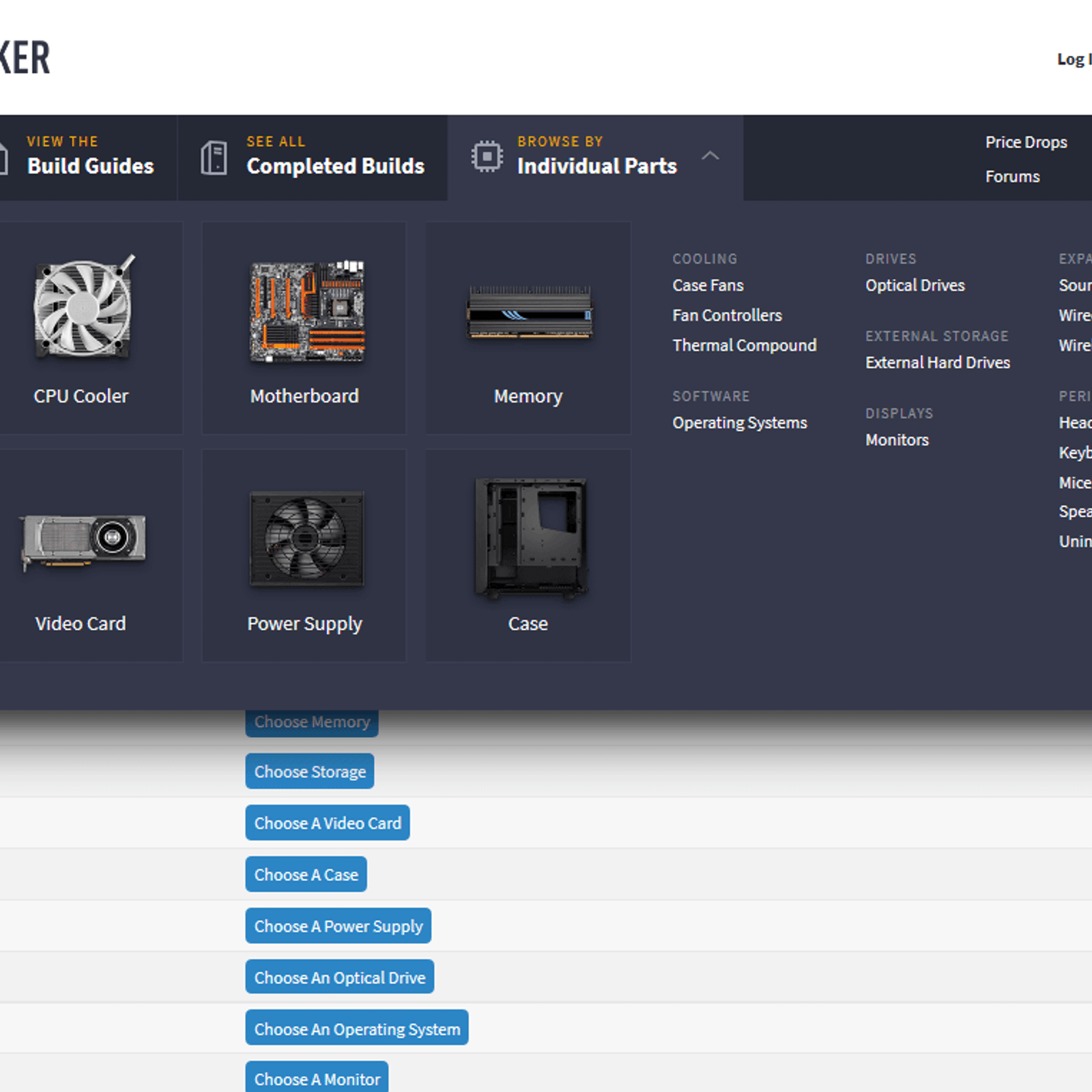Is it possible to build a dream PC without the stress and frustration that often accompanies the process? The answer, increasingly, is a resounding yes, thanks to the rise of tools like the "part picker," which are revolutionizing how enthusiasts and newcomers alike approach the complex world of computer hardware assembly.
For years, constructing a custom PC was a daunting endeavor. It demanded in-depth knowledge of compatibility, pricing, and the intricate dance of components working together. Incorrect choices could lead to performance bottlenecks, wasted money, or worse, a system that simply refused to boot. The potential for error was high, and the consequences could be costly and time-consuming. Navigating the vast landscape of processors, motherboards, RAM, graphics cards, storage drives, power supplies, and cases felt like a Sisyphean task. The lack of readily available, reliable information, coupled with the rapid pace of technological advancement, added to the complexity. Forums, enthusiast websites, and word-of-mouth recommendations offered some guidance, but sorting through conflicting advice and outdated specifications often led to more confusion than clarity. The dream of a high-performance, customized machine often remained just that a dream, relegated to the realm of the technically proficient.
Enter the part picker. This innovative tool, often found online, acts as a virtual hardware advisor, guiding users through the entire build process. It allows individuals to select components from a massive database, ensuring compatibility and offering pricing comparisons. The part picker eliminates the guesswork, replacing it with a streamlined and user-friendly experience. By automatically checking for potential conflicts, such as a CPU that doesn't fit a chosen motherboard or a power supply that can't handle the system's power demands, the part picker significantly reduces the chances of making a costly mistake. It empowers users of all skill levels to build their own PCs with confidence and efficiency. The evolution of part pickers has been a testament to the growing DIY PC building community and the need for user-friendly tools in an increasingly complex technological world. What began as a simple compatibility checker has transformed into a comprehensive resource, offering not only compatibility validation but also pricing information, user reviews, and even performance estimates.
The utility of a part picker extends beyond just verifying that components will work together. It serves as a central hub for price comparisons, allowing users to find the best deals on the market. The ability to track price fluctuations across various retailers is invaluable in a dynamic market where prices can change dramatically. By integrating with online stores, part pickers provide up-to-the-minute pricing information, enabling users to optimize their budgets. The capacity to filter components by price, manufacturer, and performance characteristics allows for highly customized builds that cater to specific needs and financial constraints. Many part pickers also include a power supply calculator, which determines the appropriate wattage for the system based on the selected components. This feature prevents the common pitfall of underpowering a system, which can lead to instability and performance issues, or overspending on a power supply unit that is needlessly large. The integration of such practical features further solidifies the part picker's status as an indispensable tool for PC builders.
The impact of the part picker on the PC building community is profound. It has democratized the process, making it accessible to a wider audience. No longer is specialized technical expertise a prerequisite for building a custom PC. The user-friendly interface and automated compatibility checks have simplified the process, making it easier for beginners to get started. Experienced builders also benefit from the tools, as they save time and effort by eliminating the tedious process of manually researching compatibility and pricing. The part picker has fostered a sense of community, as users share their build configurations and discuss their experiences online. The ability to easily share and compare builds has led to greater innovation and knowledge sharing within the community. The part picker has helped to create a more informed and engaged group of PC enthusiasts. It has allowed the community to become more streamlined and less complex.
One of the key advantages of utilizing a part picker is the assurance of component compatibility. This is crucial, as even a seemingly minor incompatibility can render an entire build unusable. The part picker's database is constantly updated to reflect the latest component specifications and compatibility guidelines. This ensures that users are always working with accurate and reliable information. The automatic compatibility checks eliminate the risk of selecting components that won't work together, such as a CPU that is not compatible with a chosen motherboard socket or RAM that is not supported by the motherboard's memory slots. This feature is particularly beneficial to less experienced builders, who may not be familiar with the intricacies of component compatibility. Even experienced builders can benefit from the peace of mind that comes with knowing that their components are guaranteed to work together.
- Dan Souzas Strawberry Refrigerator Jam Recipe More
- Luke Wilson Family Plans Relationship Status What We Know
Beyond the practical benefits, the part picker also fosters creativity and customization. By allowing users to easily experiment with different component combinations, the part picker encourages experimentation and personalization. Users can create builds that are tailored to their specific needs and preferences, whether it be for gaming, content creation, or general-purpose computing. The ability to compare prices and performance allows users to make informed decisions about which components to prioritize. The part picker is more than just a compatibility checker; it's a platform for realizing the user's vision. By empowering users to create custom builds, the part picker is helping to drive innovation and create a more diverse and vibrant PC market.
The evolution of the part picker reflects the broader trends in the technology industry. The rise of e-commerce, the growing demand for customized products, and the increasing complexity of technology have all contributed to the popularity of part pickers. The ability to research and compare components online has become essential for consumers. The user-friendly interface and automated compatibility checks of part pickers have made the process of building a custom PC more accessible. The tools have become increasingly sophisticated, with features such as power supply calculators, performance estimators, and user reviews. As technology continues to advance, part pickers will likely become even more indispensable. They will evolve to support new technologies, such as artificial intelligence and virtual reality, and will play a key role in shaping the future of PC building.
Moreover, the part picker promotes informed purchasing decisions. The tools are often linked with pricing from a variety of online retailers, offering users a consolidated view of component costs. This helps users to locate the best deals and compare prices across different vendors. Additionally, part pickers often provide user reviews and ratings for components, giving potential builders a sense of the product's reliability and performance from the perspective of real-world users. By giving users access to such a wealth of data, the part picker encourages a more informed purchasing process and prevents buyers from overspending. Its a way to make sure a user has the right to fully understand what they are purchasing. It ultimately gives the consumer a better understanding of each component. This is one of the part pickers main functionalities, its contribution to consumer knowledge of the industry.
While "part picker" is often used as a general term, there are several specific platforms that have become particularly popular and influential within the PC building community. These platforms are often distinguished by their comprehensive component databases, robust compatibility checks, user-friendly interfaces, and integration with pricing data from major retailers. Some also offer advanced features such as system configuration recommendations, performance estimators, and forums for user interaction and support. Examples include PCPartPicker, which has become the industry standard, and other platforms that offer similar functionalities and advantages. Each platform strives to offer the most complete and accurate information, making the PC building experience a more manageable and rewarding one. The competition among these platforms further drives innovation, leading to continual improvements in user experience and feature sets.
The success of a part picker hinges on the accuracy and comprehensiveness of its component database. This database is the heart of the tool, providing the information needed to verify compatibility and compare prices. The database must be constantly updated to reflect the latest component releases, specification changes, and pricing fluctuations. Maintaining such a database is a complex undertaking, requiring a dedicated team to curate and update information from manufacturers and retailers. The quality of the database directly impacts the usability and accuracy of the part picker. A database that is incomplete or inaccurate will lead to compatibility issues and frustration for users. Continuous improvement and updates are crucial for remaining relevant in the dynamic world of computer hardware. A well-maintained database is essential to the utility and reliability of the tool.
The future of the part picker is bright, with several trends likely to shape its evolution. Increased integration with emerging technologies, such as virtual reality and artificial intelligence, is expected. The tools will adapt to support the hardware requirements of these new technologies, offering compatibility checks and performance recommendations for VR headsets, AI accelerators, and other specialized components. The rise of cloud computing and remote gaming may also influence the development of part pickers. The tools could integrate with cloud gaming services, allowing users to easily configure systems that are optimized for cloud-based gaming. Furthermore, the tools may also incorporate user data and machine learning to provide more personalized build recommendations. As technology continues to evolve, part pickers will remain indispensable tools for PC builders, constantly adapting to the changing landscape of the industry.
The role of the part picker in the PC building ecosystem is multifaceted. It acts as a compatibility checker, a price comparison tool, a source of information, and a platform for community interaction. It reduces the complexity of building a custom PC, making it more accessible to a wider audience. The tools empower users to make informed purchasing decisions and to create builds that are tailored to their specific needs and preferences. The part picker has helped to drive innovation and create a more vibrant PC market. Its impact is undeniable, and its continued evolution will undoubtedly shape the future of PC building. The part picker has become an essential tool for those who wish to create their own customized PCs, and its importance will only continue to grow as technology evolves.
The impact of the part picker is not limited to the individual PC builder. The tools also benefit component manufacturers, retailers, and the PC building community as a whole. By making it easier for people to build custom PCs, the part picker increases demand for components. This benefits component manufacturers, who see increased sales and revenue. Retailers also benefit from the increased demand, as they sell more components through their online stores. The part picker facilitates the growth of a more engaged and informed PC building community. Through forums and social media, the tool encourages knowledge sharing and discussion, leading to a more supportive and collaborative environment. The part picker has created a virtuous cycle, where the increased demand for components drives innovation, the innovation drives further demand, and the community grows more robust and diverse.
Consider the scenario of a user, a beginner interested in building a gaming PC. Without a part picker, the process would begin with extensive research on CPU specifications, GPU compatibility, RAM speed, and motherboard chipsets. The user would need to consult multiple websites, read countless reviews, and pore over technical manuals to understand the intricacies of each component. The risk of making a mistake would be high, and the potential for frustration would be considerable. With a part picker, however, the process is simplified. The user can start by selecting the desired components, such as a high-performance CPU and a powerful graphics card. The part picker immediately checks for compatibility, ensuring that the selected components will work together. The tool then suggests compatible motherboards, RAM, and other components, based on the user's selections. The user can then compare prices, read reviews, and make informed decisions about which components to purchase. This streamlined process saves time, reduces stress, and makes the dream of a custom gaming PC a reality.
In conclusion, the part picker represents a significant advancement in the world of PC building. It has democratized the process, empowering users of all skill levels to build their own custom computers with confidence and efficiency. Its impact is felt across the industry, from component manufacturers to retailers and, most importantly, the builders themselves. As technology evolves, the part picker will undoubtedly continue to adapt and improve, solidifying its place as an essential tool for anyone looking to create their perfect PC. It has transformed the landscape of PC building, making the once-daunting task of assembling a custom computer accessible to a wider audience and driving innovation within the industry. This is truly a tool that provides and sustains a solid consumer experience in the world of PC building.



Detail Author:
- Name : Kara Pacocha
- Username : cristina.mitchell
- Email : camille39@grant.net
- Birthdate : 2002-05-30
- Address : 960 Murphy Unions Donnellyview, WV 67893
- Phone : +1-541-660-6588
- Company : Breitenberg-Franecki
- Job : State
- Bio : Nihil est saepe debitis. Qui libero aliquid recusandae recusandae unde qui eaque. Reiciendis incidunt ratione deleniti voluptas repudiandae quam.
Socials
linkedin:
- url : https://linkedin.com/in/larson1978
- username : larson1978
- bio : Autem voluptas quod eos cupiditate.
- followers : 2871
- following : 2489
tiktok:
- url : https://tiktok.com/@larson1976
- username : larson1976
- bio : Odio vel voluptatem minus delectus iste aspernatur adipisci.
- followers : 2484
- following : 642
instagram:
- url : https://instagram.com/shanna7382
- username : shanna7382
- bio : Ipsam voluptas blanditiis in. Dolorem cum minima sit quos quaerat. Et et modi id aut sed.
- followers : 6552
- following : 2422
twitter:
- url : https://twitter.com/shanna.larson
- username : shanna.larson
- bio : Dignissimos explicabo qui molestiae nemo. Tempore et in voluptatem aut. Magni mollitia labore quod.
- followers : 4199
- following : 2750